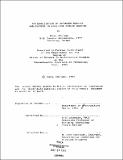| dc.contributor.advisor | Eric Dluhosch. | en_US |
| dc.contributor.author | Wang, Chi-wei, M.S. Massachusetts Institute of Technology | en_US |
| dc.contributor.other | Massachusetts Institute of Technology. Dept. of Architecture. | en_US |
| dc.coverage.spatial | a-ch--- | en_US |
| dc.date.accessioned | 2013-03-28T17:57:01Z | |
| dc.date.available | 2013-03-28T17:57:01Z | |
| dc.date.copyright | 1983 | en_US |
| dc.date.issued | 1983 | en_US |
| dc.identifier.uri | http://hdl.handle.net/1721.1/78050 | |
| dc.description | Thesis (M.S.)--Massachusetts Institute of Technology, Dept. of Architecture, 1983. | en_US |
| dc.description | MICROFICHE COPY AVAILABLE IN ARCHIVES AND ROTCH | en_US |
| dc.description | Includes bibliographical references. | en_US |
| dc.description.abstract | Because of the increasing demand for a large quantity of public housing in Taiwan, construction productivity has become an important issue. Among those building elements, the bathroom has been accused as presenting one of the more severe bottlenecks in production, due to the great number of so called "looped" operations which seriously decrease bathroom assembly efficiency in particular and overall building construction productivity in general. Many foreign countries have developed various industrialized bathroom systems to improve on-site assembly efficiency. These systems have adopted different concepts towards bathroom design and subsystem categorization which are supposed to increase assembly efficiency in their contexts. Since the elimination of "looped" operations serves the same purpose; i.e., to achieve higher assembly efficiency, it seems clear that it may also lead to the task of conceptually redefining conventional bathroom subsystems that are currently being produced and used in Taiwan. Given the situation that, in Taiwan, we should first try to rationalize our construction methods instead of leaping directly into industrialized ones, a situation which has been taken for granted by both the government and the private sectors as a remedy for the current housing shortage dilemma, this thesis tries to rationalize conventional Taiwanese bathroom assembly processes by examining the "looped" operations in relation to bathroom subsystems as a pilot study for more rationalized, assembly-efficient bathroom designs, and eventual or possible industrialization. | en_US |
| dc.description.statementofresponsibility | by Wang, Chi-wei. | en_US |
| dc.format.extent | 115 leaves | en_US |
| dc.language.iso | eng | en_US |
| dc.publisher | Massachusetts Institute of Technology | en_US |
| dc.rights | M.I.T. theses are protected by
copyright. They may be viewed from this source for any purpose, but
reproduction or distribution in any format is prohibited without written
permission. See provided URL for inquiries about permission. | en_US |
| dc.rights.uri | http://dspace.mit.edu/handle/1721.1/7582 | en_US |
| dc.subject | Architecture. | en_US |
| dc.title | Rationalization of bathroom service sub-systems in high-rise public housing | en_US |
| dc.title.alternative | Bathroom service sub-systems in high-rise public housing, Rationalization of | en_US |
| dc.type | Thesis | en_US |
| dc.description.degree | M.S. | en_US |
| dc.contributor.department | Massachusetts Institute of Technology. Department of Architecture | |
| dc.identifier.oclc | 11451550 | en_US |
